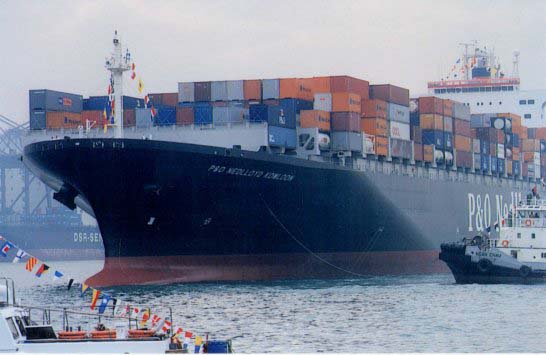
In 1999 I was busy with a short course (2 years) higher nautical and engineering academy. For the summer holiday I registered myself at some 'sailors' employment agencies. The first one who called me they had a job was TOS (Transport & Offshore Services). They offered me a job as integrated officer on board ms. P&O Nedlloyd Kowloon for a trip from Europe to Japan. More below you can read about the trip I finnaly made on an other P&O Nedlloyd vessel. At Yoroen's sailing you can read more about the other ships Yoroen sailed on.

This is the P&O Nedlloyd Kowloon. At that time she was one of the biggest container vessels from the world. Some facts about the P&O Nedlloyd Kowloon, the containercapacity is about 6600 20foot containers (TEU). The Kowloon is approximately 300 meters long and for it's propulsion the formerly largest dieselengine (about 96.000 hp) in the world is in use! The propeller weights 90 tonnes (90.000 kg). Service speed is 24,5 knots (45 km/hr).
The voyage should go from Rotterdam to Singapore, Japan and back, but the employement agency had a sailor who had sailed before on the Kowloon, and he was preferred for the job. Logical decision, with a ship aged about 6 months (June 1999). So I was planned to go to an other vessel, the ms. P&O Nedlloyd Sydney.
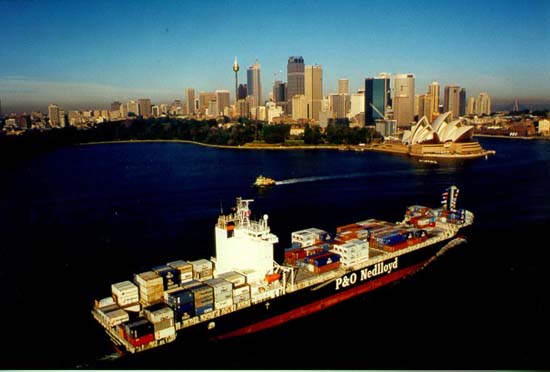
There she is in the city where she is named to. She is smaller then the Kowloon, only
209 metres. But that is still 2 times bigger than the biggest chemicaltanker I sailed on
before. For boarding the vessel I flew to HongKong. First we anchored for about 2 weeks at
HongKong roads, thereafter we sailed to Qingdao (China), Pusan (Korea), Los Angeles and
Seattle wherefrom I flew back to Holland after being away for about 6 weeks.
Some ships particulars:
Width : 32,3 m
Summer draught : 12,50 m
Air Draught : 53,46 m
International Gross Tonnage : 31333 mt
International Net Tonnage : 18650 mt
Bunkers, Heavy Fuel Oil : 4431 m3, Diesel oil : 186 m3, Lubricating Oil : 312 m3.
Tanks: Water ballast : 10444 m3, Fresh Water: 195 m3.
Main Engine : MAN B&W 8K80MC-C, 28880 kW (about 36.000 pk) @ 104 rpm
Propellor: 6 blades diameter: 7,3 m
Bowthruster: 1300 kW (about 1750 pk).
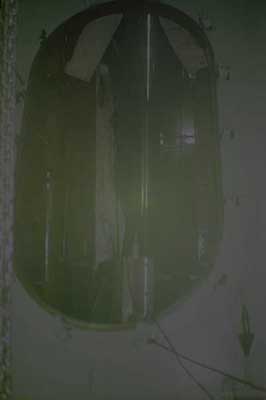
On the picture above you have a view into the main engine, you can see the crank in the middle. As you can see (hopefully) there are 2 man working in the engine. It's a huge engine, about 11 metres height. very impressive to work on such a machine. Due to the anchoring for 2 weeks at Hongkong roads we had the time for such a job, an inspection of the crosshead bearing. It was very impressive such a big engine, also when you think it is running 104 rpm (revolutions per minute).
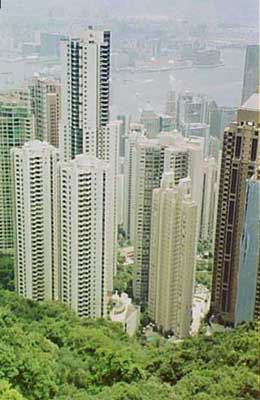
Of course I had some time to go ashore in Hong Kong. I was able to go to the Victoria Peak while there weren't any clouds up there, and over there I took this picture. On the foreground you see Hong Kong and the background is Kowloon, an other part of Hong Kong. I went there together with a cook, and checked the beer prices in Hong Kong :)
The text continues now with my experiences on board ms P&O Neddloyd Sydney. I worked on her for about 6 weeks in my summer holiday as 4th Maritime officer (integrated officer). I flew to Hong Kong where I boarded her the day after I arrived. I didn't sleeped so well on the flight from Amsterdam to Hong Kong (11.00 hours?) so I took some sleep in the Panda hotel.
In the early morning I was waked up in the hotel and I explored their showers :( . I am about 2 meters (m) tall, for Hong Kong it must be very long. The shower was fixed at maybe 1,60 m or 1,70 m. Not so funny when you like to wash your hair :(
With the agent I went to a containerterminal where we went on a tender to the ship. The P&O Nedlloyd Sydney was for anchor. The only containers on board were empty. We were fased in as first vessel in a new loop, the CKX: China Korea Express. All the empty containers were unloaded with cranepontoons while we were at anchor. Its not so clear to see on the pic from the tender :( One of the pontoons was near the gangway so we had to wait before I could board the P&O Nedlloyd Sydney. In a day of 12 we would start loading and depart to Shanghai, Qingdao (both in China), Pusan (South Korea), Los Angeles and Seattle. In Seattle my voyage was finished but the vessel proceeded thereafter to Pusan and Hong Kong for the next loop.
In the days for anchor I was possible to go ashore a few times. The 2nd, 3rd and 4th (me) integrated officer and the chief cook went one evening ashore to the Kowloon Site. I also went ashore a sundaymorning till the evening. The tender brought us near Kowloon Ferry pier, where I took the Star Ferry (sea the pic) to Hong Kong side. The wather was fine so I was possible to took a nice look of the view from Victoria Peak.
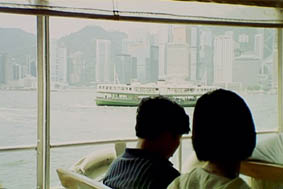

The picture on the right was my cabin. It had its 'own wet cel' with a shower, a toilet and a washstand. The cabin was located at the front side of the accomodation on the 5th deck. Two decks up was the bridge. The window has a view on the deck, the first 4 holds. But when we had loaded my only view was a view of the highest containers. That's a pic some more below. You use the cabin mostly for sleeping and washing (showering). Sometimes to write a letter or for reading. It was also possible to email onboard. On the computer network we worked with Ship to Shore for Windows. Via gncomtext.com and the sattelite (Inmarsat the email was sended and received twice a day from and to our ships email adress. The captain fowarded private email to your personal inbox. Off course no attachements but I appreciated this way of fast communicating with home. There was also the possibility to use a fax gateway. Much faster then snail mail, that at the fastest way was minimal a week. Email with the time difference between Europe and Hong Kong was most of the times in 2 days possible.
Because of an approaching typhoon we heaved anchor and went to a safer anchorage with better holding ground. The typhoon changed course and didn't come along Hong Kong, so we returned back to Hong Kong roads after a day. After the two weeks anchoring. A few days more we moored along a container terminal. I gone ashore for maybe an hour with the chief cook to the seamens house. Unfortunattely it closed in a short time. But that was better for my time to sleep ;)
We were the first ship in the new loop, by some 'growing pains' our call at Sjhanghai was cancelled, so we proceeded a bit more slowly to Qingdao. A new typhoon was approaching the Yellow sea where Qingdao was located. That's why we tried to seek some shelter, but again the typhoon altered course and went over South Korea, just east from us.
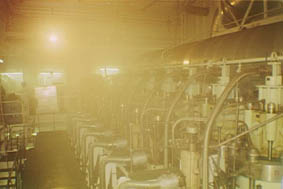
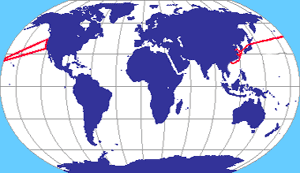
On the left above there is a view in the engine room on the top deck of it. At this deck was for instance the engine control room located. You see now the top of the main engine. A MAN B&W L80MC, the 80 means a bore of 80 cm's. Because of the lightning in the engine room it is difficult to get a clear view on the pic :(. On the right you can see the exhaust gas pipe. The big hoses are the hydraulic oil hoses that opens via actuators the exhaust valves. The engine power is 36.000 hp which gave the ship a speed of 22 knots (a knot is 1 seamile per hour, a seamile is 1,852 km so that is 40,7 km/hr).
On the right is the loop of the P&O Nedlloyd Sydney when I was on board. Actually the P&O Nedlloyd sails another loop. You can check that via the P&O Nedlloyd website with the vessel tracking system.
After Qingdao we sailed a day to Pusan where after we departed for the long trip to Los Angeles. That was about 11 days sailing, and a time difference of 8 hours and a crossing of the datelimit. That meant that we had to change the time -23 hours, or the clock one hour forward and a day back. The captain planned that on sunday till monday night, so we had two quiet sundays on sea. The weather was not so good when we sailed across the Pacific. Although it was summer there was much fog. We had a good visibility when we could see the foremast ;) And that for 6 or 7 days.....
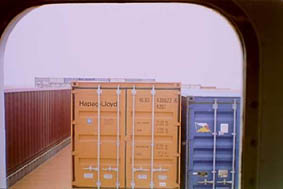
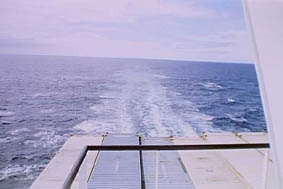
The left pic above this part of the text is the view from my cabin onto deck. On the right you see the containers on the hatch of hold number 5 and the astern view. The next call Los Angeles was the first call of the P&O Nedlloyd Sydney to the United States so we expected a coast guard inspection. The ship was only a year old so that couldn't be a problem. As 4th officer I was also the safety officer so I checked almost everything of the safety and lifesaving equipment during that trip. Of course not when I had the watch on the bridge or when I was busy in the engine room.
We arrived sunday afternoon (15 august) at Terminal Island Los Angeles (Long Beach). The evening we spent ashore with 3 of the integrated officers and the chief cook. The next morning I had a head like a pencil, but I had a good job to do. The cleaning of some heavy oil filters. The cadet assisted me. The coastguard was there too that monday morning. The also liked us to do an abandon ship and a fire drill. We lowered the port lifeboat and tested the engine. The inspection was passed succesfully. No remarks.

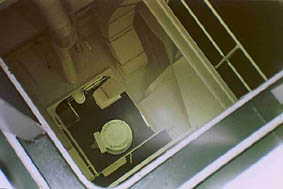
The next day we left Los Angeles heading Seattle. That trip an auditor from the head office made a first audit to check if we could pass initial ISM audit (International Safety Management). More information about ISM is on the International Maritime Organization website.
The left picture is the bulbuos bow seen from the foredeck, from above so. On the right another pic taken from above (in the forecastle) but now from the electric motor which drives the bow thruster. A bow thruster is used only by manoeuvring, that means that the speed should not be more than approximately 6 knots (about 11 km/hr) while you use it. For instance as assistance when mooring alongside a jetty or quay.
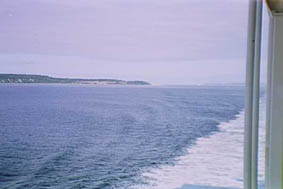
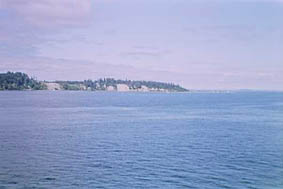
Before arrival Los Angeles we had a little party. The party started at 16:00, so I went to the bridge and the master went down to the bar. About 18:00 my shift was over and the 1st mate was on watch. Long enough for me to have a little part of the party. Half past 6 was dinner time. The master was going for leave, and there came also a new chief engineer. The for leave chief engineer was going with me in Seatle from board. Our portstay in Seatle was minimized due to a strike of the truckers. We also gave a little party but now it was my party and I was of duty ;)
The pics were taken in the morning on the Puget Sound, the water between Canada and the United States of America leading to Seatle and Vancouver. My flight was one day later. According the normal scheme the ship should leave Seatle the same day, due to the strike it became 4 o clock.That's why we went in the afternoon first to the immigration , second we were brought to a motel near SeaTac airport. Had a good dinner, felt after that almost in sleep in my motel room. I awaked and liked to check a pub in Seatle. The town was a half hour or more by car. I didn't made that. The airport service from the motel gave me a 2 minutes ride to a good pub, I think the pub was named Five Coins or something like that. Short enough to walk back ;)
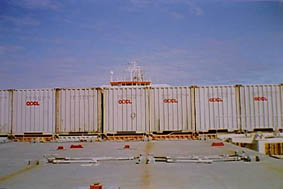
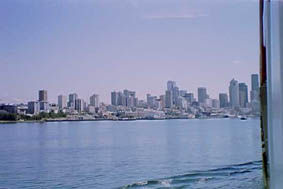
Still some more pics ;) The left one is taken from the front of the hatch of hold 1. The ship had 5 holds. Four in front of the accomodation and engineroom and one aft of them. Some of the holds were suitable for dangerous cargos. For instance: in that hold was explosion proof illumination. On the hatch you see the turnbuckles. We use them for securing of the cargo. Thereafter the first containers on deck and the bridge with some antennas and the monkey island. The monkey island is the place of the magnetic compass.
The other pic is a part of Seatle's skyline.
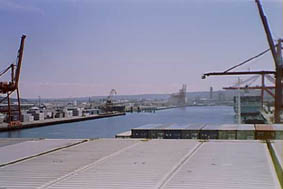
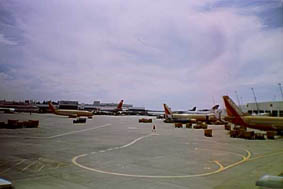
On the right we were just moored alongside the terminal. The photo is taken from the port wing of the bridge. Some further on the terminal is a Maersk container vessel alongside (The blue one).
And the last pic is on Seatle Sea Tac airport. Last part of my trip around the world in 6 weeks. A flight of 8 hours to Schiphol airport in Amsterdam, Holland. Sleeped very well in the plane, but to short. In the Seatle it was about 9 or 10 hours earlier than in Holland. My dad and my girlfriend came to the airport while I was broken from the time difference. But they woke me up a bit ;)
You can see another pic taken from the air at the Summer 1999 page. The last picture is taken by a classmate of the higher nautical and polytechnical college. He was also working via the same employment agency by P&O Nedlloyd. The pic is taken from the APL Germany, a chartered vessel. The P&O Nll Sydney was then for anchor in Hong Kong. He saw me, but I did not see him ;) Thanks JPH.
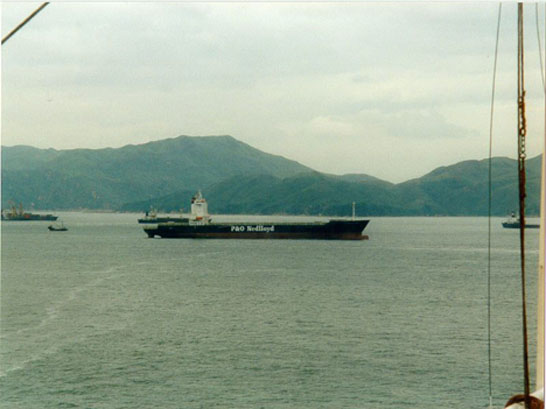
I would also like to thank the employee off P&O Nedlloyd's office in London for sending me some pics. P&O Nedlloyd homepage.